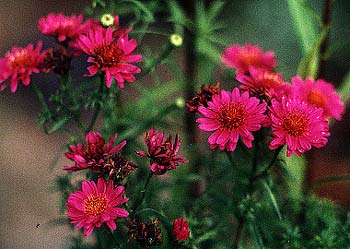
Hardy Asters
"The starry asters glorify the waste."
-Walter Malone,
1867-1915
1867-1915
Many of the brightest-flowering garden asters are sold as "mixed asters" or just as "asters" with no attempt to identify specific cultivar or hybrid history. There are so many species of asters used in so many generations of hybrids that by now many garden asters just cannot be identified. Such is the case of the bright magenta red aster with blood-read center, shown here, photographed in July (2002).
It was obtained as a small start with no name beyond "Aster." It is surely descended from one of the New England wild asters, but whether hybridized A. novae-angliae, A. novi-belgii, A. dumosus, or others, I doubt this can be known. Any withA. dumosus in the heritage tend to be smaller in stature, & the magenta clump only grew to about fifteen inches (many that are dominated by A. novae-angliae grow four to six feet).
So many different asters have been so widely used for such a very long time that sorting them out by species is difficult or impossible to do in retrospect, & the hybrids end up categorized collectively as "Hardy Asters." If knowing more precisely does matter, a gardener will have to pay a bit more for named cultivars that in most cases perform no better or worse than unknown mixes.
Hardy Asters are all-purpose in the garden. They do well in sunny or partly shaded locations (they will not flower so well in much shade), or in moist or dry locations. They are among the best host-plants for butterfly larvae & dramatically increase a garden's butterfly population. Their small daisy-like blooms occur late summer & autumn, though some begin blooming earlier in the year.
They come in so many bright colors: blue, white, purple, pink, lavender, & red. The majority are in the blue to violet range. With deadheading & occasional trimming down & thinning throughout the long bloom period, they remain compact clumps reblooming continuously until it's just too cold to bloom again.
Hardy Asters should not be much fertilized or they'll just get floppy & too tall & need division all the sooner, without blooming any better than when fertilzed very little.
This particular clump, though blooming wonderfully summer & autumn, did not return for a second year. Though hardy asters do easily perennialize, it is very common that they function as defacto annuals, & should perhaps be planted as annuals so as not to disappoint expectation.
To increase the odds of their returning year after year, they can be dug up in October, divided in half with the centermost part of the clump discarded, then the healthiest edge-bits replanted & mulched against winter chill, in areas of sharp drainage to limit excessive winter wetness. That much care for what is essentially a very cheap plant can be a bother, especially when some varieties nearly always behave as annuals no matter what one does; so it is sometimes simpler just to replant new ones each year, & be happy whenever a favorite one does perennialize.